The essential oil business is booming, distributors and overnight “experts” are popping up all over as are training programs to promote better understanding.
For the average consumer though, knowledge, a good dose of common sense and some discernment to sift through the hype will pay dividends as you invest in essential oils. In this market, you often get what you pay for.
Cheap price is often an indicator of low quality goods. If the price seems too good to be true it probably is. This is a market known for filling and diluting essential oils to stretch profits. There are few FDA guidelines (be wary of companies thrusting their self-made trademarks or terms that appear to be official) to protect consumers from truth in labeling that still shelters manufacturers who are filling products with fragrance chemicals to protect their “trade secrets”. There are no regulated terms such as “medical grade” or “hospital grade”.
If you are weary of companies selling “food grade” essential oils, take heart. You most likely have been consuming them already in other consumer goods without knowing it, so it pays to get what you know is a good quality, food grade essential oil that is pure with nothing added. Here are some more tips to help you decide what is best for your family.
- Trust your sources talk to owners, see how they are growing and distilling their oils and how long they have been producing essential oils. Farmers and producers who are working the land will be able to give you first hand knowledge of how they are making their oils, what kind of equipment they are distilling oils (if at all). Most distributors are just buying their oils from brokers who might be mixing together oils (additives) from several farms and you lose that identity of where the oil really came from. Were other oils distilled on the same equipment? What equipment was used to distill the oils? At what temperatures? Distilling essential oils is no different than processing foods. Take apple juice for instance. You could buy a major brand “apple juice” that has traditionally grown apples from many farms, it’s been pasteurized, used pesticide sprayed apples and who knows what else is in that juice box. Then you have a local apple cider from a farmer you know. You can buy the cider directly from the little farm shop or from area stores who stock their apple cider. This product has an identity you can trace and people you can talk to to learn about how they process that apple cider. An organic apple juice producer most likely has farms they own and manage, there is an identity to the product and they test their products for chemicals, pesticides and quality. Essential oils are the same. Look for companies with an identity in most of their products. Can they trace back their sources? Do they own and manage the sources? Ideally, the best companies will own, manage and distill their oils on the farms for complete quality control.
- Knowledge & Wisdom Look at the companies owners: their background and experience. Is the experience in growing/distilling/farming essential oils or in marketing? Was their company built out of a desire to farm and produce the best quality oils or a desire to create a marketing empire? A passion for ethical farming and really wanting to improve the human condition & better the environment puts company priorities in making the best oils. Greenwashing is when companies use a platform for marketing natural products using terms that might be vague, subjective or reaching for a feeling rather than science.
- Consistency consider the placebo affect. Many products will make you feel good short term. A company that is selling a sub-inferior product and marketing it as Authentic, Pure, 100% natural or any other marketing term to “sell” you might make you feel good today but there could be dangerous consequences when essential oils are used unsafely, casually or poured out in large concentrations for ingestion, especially if there are unknown fillers or synthetics in an essential oil. The pure plant oil will actually help chemicals in an adultured oil absorb quickly into your system for an unknown upload of ingredients, whatever they may be. If you are encouraged to use up a product quickly before it breaks down, you lose the ability to compare and notice consistency over time as the product does or does not remain stable. A good quality essential oil will last a long time (citrus oils will break down sooner as will any EO that is exposed to air, sunlight, extreme temperature changes and chemical interactions if you are touching the bottle orifice with your fingertip: that little plastic part that the oils come out of)
- Trust your senses Essential oils should smell different. They have different properties and antioxidants. A company that has essential oils with a similar note to all oils (vanilla, or other “scent” to help identify a brand) is a red flag that they have been tampered with. Secret scents have been around for over 100 years and the driving force behind the Fair Trade Labeling Act which exempt companies from listing ingredients in their fragrances to protect their unique chemical fragrance that stood out from their competitors. Some of these chemicals are harmful, but some are derived from essential oils. Orange juice companies commonly add natural and artificial “flavors” to their juices to help their products taste different from their competitors. This can be the case with essential oils, where one companies “peppermint oil” may smell different from competitors. Unfortunately, in the essential oil industry, this is not a benefit, but rather an indicator that something is amiss. The more you smell true essential oils and eliminate chemicals from your life, the easier it will be to identify those subtle differences in essential oils and you will be surprised at how smart your nose is! Open those bottles (make sure they are testers at the store!) and smell, smell, smell. Food Flavorings ARE NOT therapeutic oils! But pure, therapeutic grade essential oils CAN BE food flavorings. It’s important to know the difference :).

- Trompe L’Oiel Color is a simple test you can use to look at the potential quality of an oil, but it may not be what you think with essential oils. Americans are driven by our senses: bright color=quality, quantity=quality, etc. It’s not unusual that we rationalize many things despite what our eyes may see. But in the case of essential oils this can be a benefit if you are really observant and look at essential oils objectively, not emotionally. Simple observations can be powerful. Note the difference in colorings of the two Orange oils in the video below. Both are labeled Citrus Sinensis, one is super bright orange which some may argue is because of the high amount of sinensis in it which is traditionally not the case with an essential oil. Could it be added colors to appeal to our American senses ? According to Robert Tisserand in the 2nd edition of Essential Oil Safety, “the majority of essential oils are colorless or pale yellow, although a few are deeply colored, such as blue chamomile, and European valerian, which is green.” The orange oil on the left was significantly dark orange compared to the bottle on the right, it does appear even lighter on the paper than I photographed.
5. Orifice droppers control the flow of your oils out of the bottle. A good quality orifice cap will properly control the flow of essential oils out of your bottle. Essential oils are valued substances that should be respected and treasured. That’s why essential oil bottles are small, you don’t need much and they should last a long time if you store them properly: in a cool, dry location out of direct sunlight. Classic aromatherapy practices require only 1 drop of an essential oils for many applications, the oils that you purchase should allow you to get just one drop safely and frugally without 2 or 3 more flowing out accidentally. Keep in mind that many essential oils also behave very differently. Many oils are thicker than others: myrrh, vetiver, spikenard are some thicker oils that naturally need to be coaxed out of the orifice. Citrus oils tend to flow quicker, which makes it even more important that those bottles have the correct orifice on it. If a company is selling you oils that come pouring out you will buy more…..Every time you try to get “one drop” you get 3 or 4….simple economics :). Check out the video here to observe the flow of 2 orange oils out of different bottles. They are from two different companies and different orifice caps which drop out at a significantly different rate:
6. Chemistry of the essential oils should be provided upon request and consistent with other producers. Producer should be able to provide chemistry of any essential oil they sell with definite standards vs open ended values. For example, lemon essential oil from one company has B-caryophyllene listed as <5% when all other resources I have don’t even list B-caryophyllene as a detectable constituent…..it is of course found in other essential oils like (Frankincense 6.6%), (clary sage 1.1%), (Bulgarian Lavender 4.1%), (Sage .2-3.7%), (Copaiba 24.7-53.3%). According to Robert Tisserand’s Essential Oil Safety, 51 essential oils are listed as having B-caryophyllene and lemon essential oil is not among them……hmmmm, we might consider that “one of these things is not like the other” and not worthy of purchasing with our hard earned cash. Interestingly, B-caryophyllene is found in Lemon Leaf…..which may be a short cut filler added to true lemon essential oil (coming from only the rind) which would cause it to behave much differently than a pure lemon oil.
7. Ethics & Sustainability True essential oils come from raw plant material. Yes, the essential oil industry is booming and that is good if consumers are adding these to their whole living routines, but they deserve respect and social responsibility. Some practical questions to ask a distributor: Are they practicing sustainable harvesting? planting trees/plants each year to compensate for their production? Do they invest in the land and work it themselves or do they just “own” the land (and the people, with no other interest except using the land and the people to make more money). History has shown many companies that have just moved into areas and reaped the harvest from naive locals and stripped the lands of economic goods to achieve market share. These tactics are similar to the British who took over salt, tea, coal and cotton production in India. The British powers in India were driven by the British East Indies company, an organization that began as a group of merchants selling goods but became replaced by greed, power and conquest driven by the simple motive to make more money). The end result is the same, when a company is driven to have the greatest market share, they may do what they can to achieve great sales and use natural plant material as a simple commodity, the land and the inhabitants will suffer. Please buy your oils from companies that are producing oils ethically, responsibly and for the right reasons.
8. Expiration Dates Does the distributor encourage you to use up oils before an “expiration date”? There are no formal regulations by FDA to put expiration date, in fact it’s up to the manufacturer. Citrus oils will degrade over time but other oils, like eucalyptus, actually improve with age (EO’s the fine wines of personal care).
Which of these do you consider most important when selecting essential oils? Have you had conversations with essential oil producers about their quality? I encourage you to leave useful information below. This is not a forum for promoting your certain brand and long comments with personal drama will not be posted. Cheers!















No comments yet.